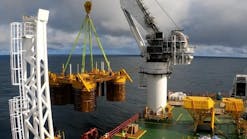IHS: Eagle Ford shale compared favorably with Bakken formation
The Eagle Ford shale play in South Texas is a contender for the best tight oil play in the US based upon strong drilling results, large prospective area, and magnitude of resource potential, said a new report from IHS Inc.
The IHS Herold Eagle Ford Regional Play Assessment said typical well performance as well as peak-month production of the Eagle Ford’s best wells exceeds wells drilled in the Bakken formation, often considered the tight oil standard.
The Eagle Ford’s favorable outlook is reflected in a competitive merger and acquisition environment, with implied deal values averaging $14,000/acre for Eagle Ford acreage in 2011 and top prices approaching $25,000/acre, IHS said.
“Our analysis at IHS indicates that Eagle Ford drilling results to date appear to be superior to those of the Bakken,” said Andrew Byrne, director of equity research at IHS and author of the study. “Although the well counts aren’t nearly as high at this point in development of the Eagle Ford, the peak of the well-distribution curve compares favorably with the Bakken.”
The most frequent Eagle Ford well result is 300-6,000 b/d for a peak month production average, Byrne said, compared with 150-300 b/d for the Bakken. The best wells in the Bakken have an average peak-month production rate of 1,000 b/d or more, while the Eagle Ford central area’s top wells are even better on a boe basis.
“The central area of the play has outperformed other areas and has been the focus of most of the drilling to date,” he added. “The western area is the next best, with the eastern area having the least activity and performance lagging the other two areas,” Byrne said.
The central area encompasses the following counties: Gonzalez, western Lavaca, DeWitt, Wilson, Karnes, Bee, Live Oak, Atascosa, Dimmit, and eastern Mullen.
The Eagle Ford is divided into three distinct windows: the oil window, the liquids-rich gas window, and the dry-gas window. The highest maximum average 30-day production rates to date on a BOE basis have been reported from the liquids-rich window, where liquids production benefits from the natural gas lift.
The favorable drilling results to date in the Eagle Ford have resulted in rising M&A interest in the area. Implied deal values have been increasing, with several billion-dollar transactions for largely undeveloped acreage packages announced during the past 18 months, he said.

Paula Dittrick | Senior Staff Writer
Paula Dittrick has covered oil and gas from Houston for more than 20 years. Starting in May 2007, she developed a health, safety, and environment beat for Oil & Gas Journal. Dittrick is familiar with the industry’s financial aspects. She also monitors issues associated with carbon sequestration and renewable energy.
Dittrick joined OGJ in February 2001. Previously, she worked for Dow Jones and United Press International. She began writing about oil and gas as UPI’s West Texas bureau chief during the 1980s. She earned a Bachelor’s of Science degree in journalism from the University of Nebraska in 1974.
